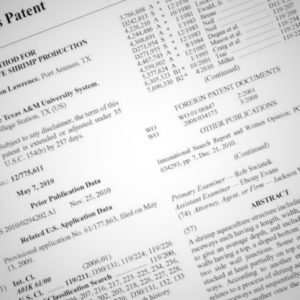
Patent
Copyright
Trademark
Plant Variety Protection
Contractual
Intellectual Property protection can be accomplished in different ways depending on the type of technology and/or commercial opportunity. IP protection provides a legal basis for protecting Texas A&M System IP, but it also helps to define what we are granting rights to in license agreements with companies. The following summarizes some of the common forms of IP protection we utilize.
Types of IP Protection
Patent
Patent protection is appropriate for devices, compositions of matter, methods, designs, and most types of asexually propagated plant varieties. Patent rights themselves don’t allow anyone to make or use a patented technology, rather it grants the owner the right to prevent others from making, using, selling, or importing the technology.
Copyright
Copyright protection is inherent in original literary works, performing arts, visual arts, digital content, motion pictures, and photographs. Registration of copyright is not required, however, doing so affords us more options for legal remedies should someone infringe on our copyrights.
Our office does not usually deal with pedagogical, scholarly, or artistic works you may create in your role as an A&M System employee. Most of our work dealing with copyrighted subject matter involves software that may be useful to companies.
Trademark
Trademarks are words or logos associated with goods or services. With few exceptions, we don’t license a trademark by itself. Most of the time when we do license a trademark, it is in conjunction with other rights (Patent, Copyright, etc.) that we have licensed to a company.
Plant Variety Protection
Plant Variety Protection (PVP) rights are administered through the USDA with certificates of protection for new plant varieties. In the past, this has been for sexually reproduced (seeded) plant varieties and tubers (potatoes). Recent changes to U.S. PVP regulations now also allow asexually propagated plant varieties to qualify for protection as well.
Contractual
Sometimes we work with technologies that may not fit the patent, copyright, or PVP mold. Other times the technology may be patent or copyright eligible subject matter, but the commercial opportunity may not justify or warrant the expense of seeking such protection. This is often the case with tangible research materials such as cell lines, certain plant materials, and know-how. In these cases, we can contractually allow a company access to the technology under terms of a license agreement.
Protecting IP Rights
The first step in protecting IP rights is to disclose your technology to our office. While the disclosure submission does not create a form of IP protection itself, it does provide useful information for us to determine what type of IP protection may be available and will be important going forward if we decide to seek patent, copyright, or PVP protection.
Protecting IP rights is important because it forms the basis for what rights we may grant to a company for utilizing the technology, i.e. making and selling a product, improving a process, or providing a service. In addition to helping define the rights to be granted in the license agreement, IP rights also form a legal basis for addressing infringement of those rights by third parties.

